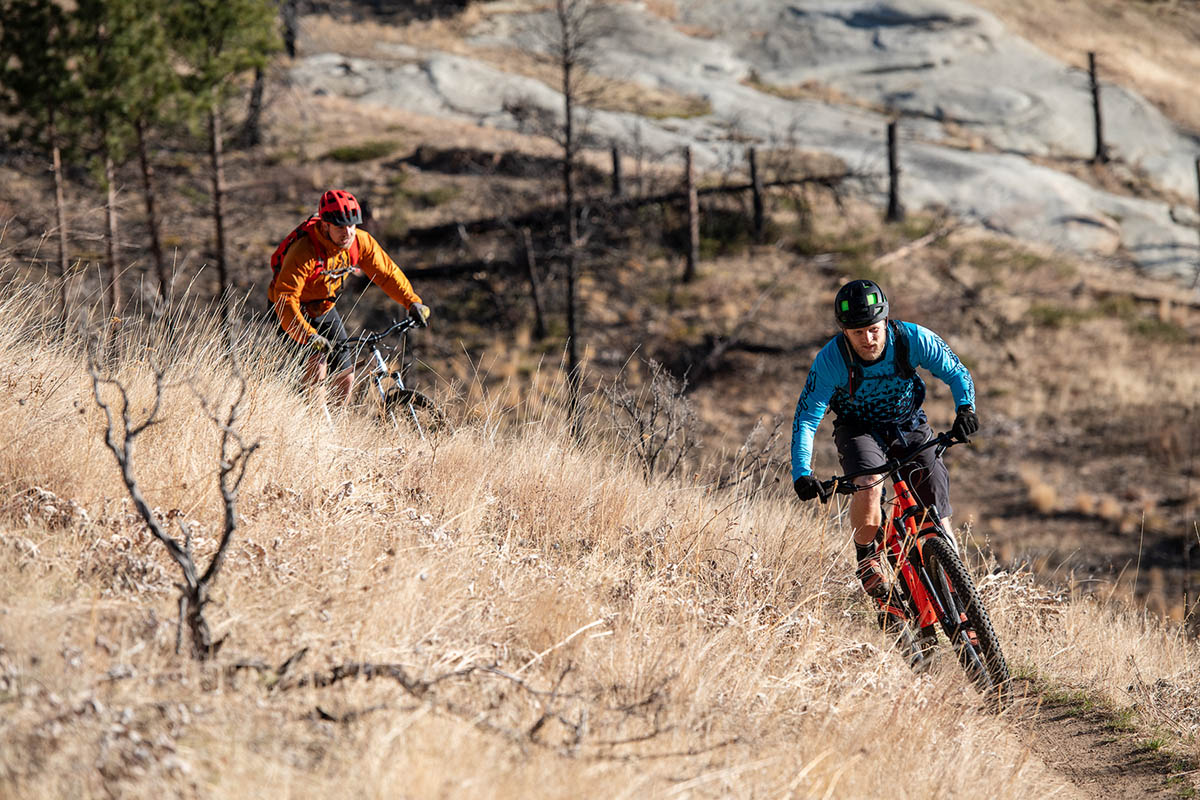
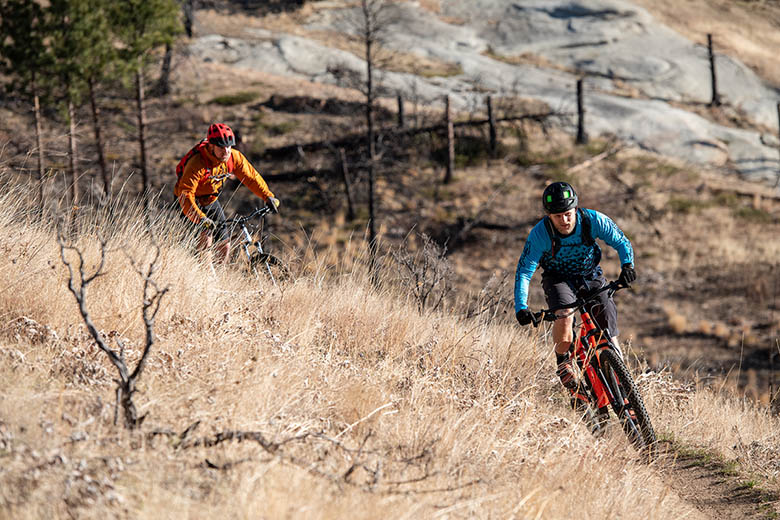
Switchback Travel (Jason Hummel)
Mountain biking can be a very expensive sport: There are hundreds of excellent bikes available for $4,000 to $6,000, and those aren’t even at the highest end of the price spectrum. Fortunately for those of us not ready to spend so much on something without a motor, there are plenty of great bikes for under or around $2,000. And the good news is that much of the technology that has pushed the sport year over year has trickled down into this category. Below are our picks for 2022, which range from lightweight XC hardtails to all-mountain-ready full-suspension rigs. For more background information, check out our comparison table and buying advice found below the picks.
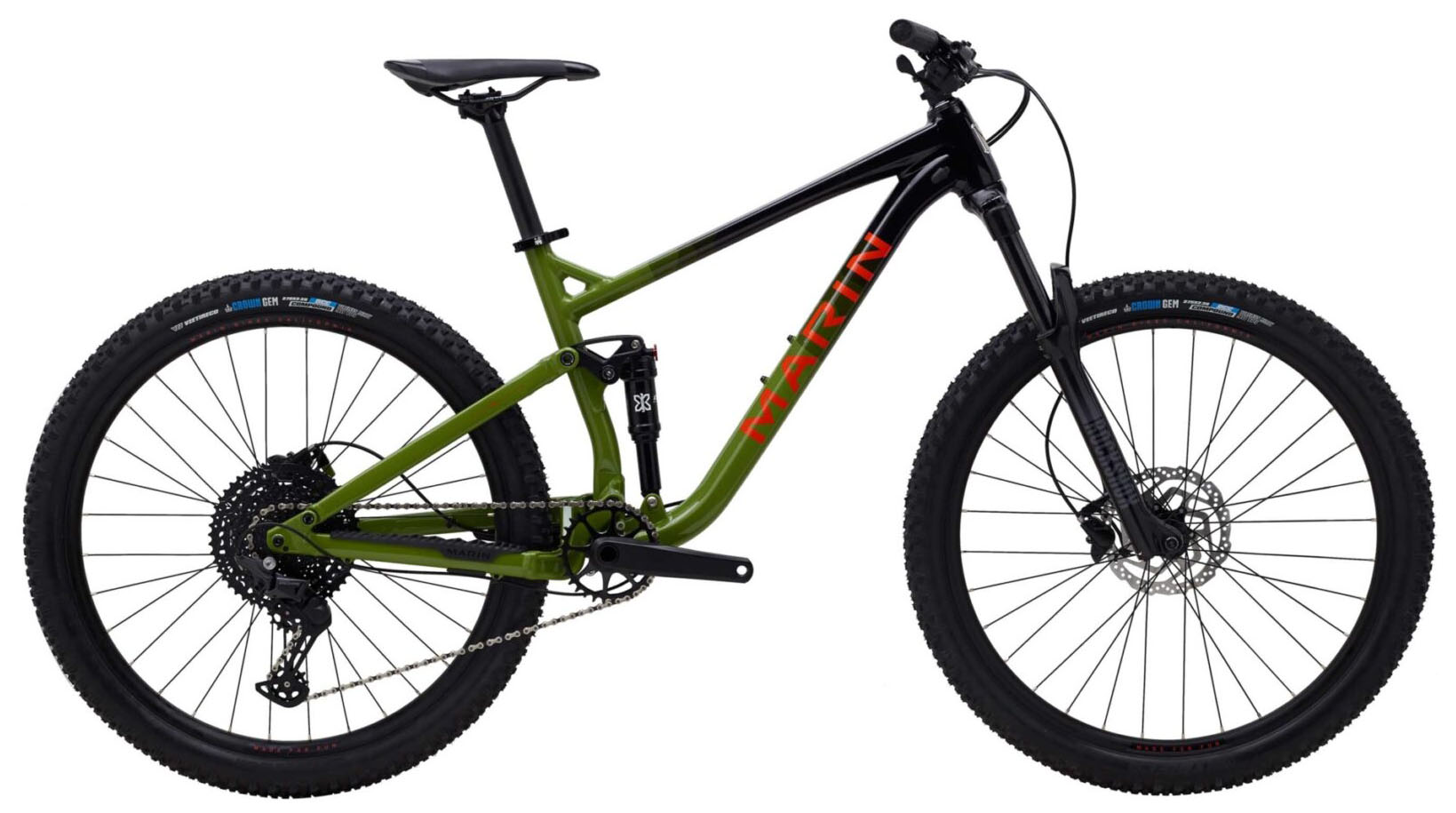 Category: Trail
Category: Trail
Suspension: 130mm (front) 120mm (rear)
Tires: 27.5 x 2.3 in.
Gears: 1 x 11
What we like: Fantastic price for a well-made, fun, and capable bike.
What we don’t: Doesn’t come with a dropper post.
It can be a real mixed bag in quality and performance for full-suspension bikes under $2,000, but Marin has a real winner in the Rift Zone 27.5 line. Their entry-level model, the “1,” nails all the right features with a sturdy and high-quality aluminum frame, modern geometry that’s slack enough for capable descending but comfortable on the climbs, and an 11-speed Shimano Deore drivetrain with a very wide range. Plus, they’ve managed to include tubeless-ready tires and wheels. At $1,899, the Rift Zone 1 adds up to a fantastic value.
With 120 millimeters of rear travel and 130 millimeters up front, the Rift Zone is well-suited for anything from longer cross-country rides and flowy trails to moderately technical downhills. It’s true that a hardtail at the same price will be sprightlier and faster on a long climb, but the Rift Zone doesn’t give up much and is far more planted over rocks and roots. If we were to nitpick, we’d like to see stronger brakes, an upgraded front fork, and a dropper post to match the otherwise impressive capabilities of the bike. Stepping up to the “2” addresses both of those issues, but that pushes the price over our threshold at $2,349. And finally, Marin also offers a Rift 1 29er, which features the larger wheels, 5 extra millimeters of rear travel, and a slightly slacker head tube for better downhill performance.
See the Marin Rift Zone 27.5 1
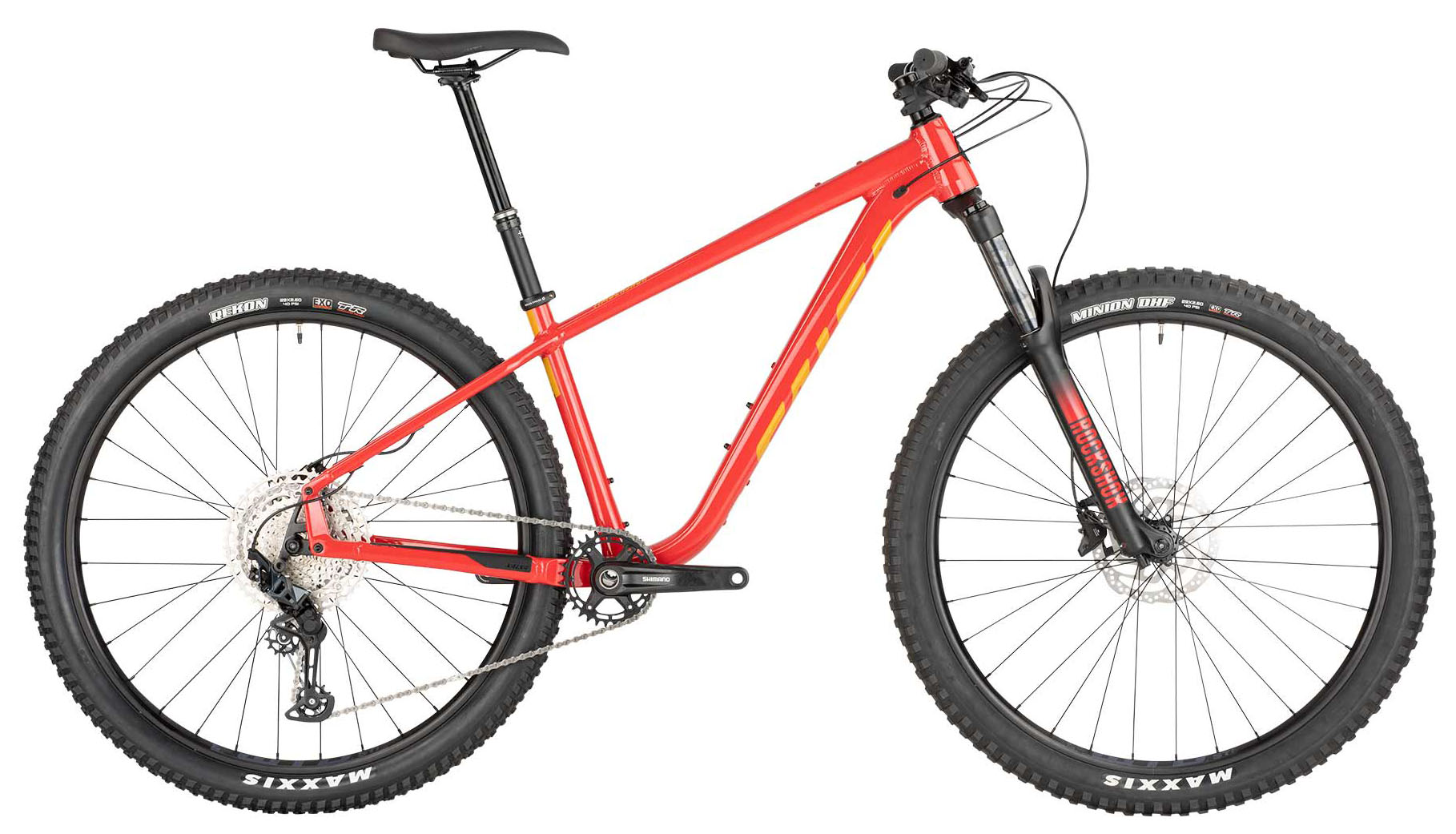 Category: Trail
Category: Trail
Suspension: 130mm (front)
Tires: 29 x 2.6 in.
Gears: 1 x 12
What we like: The most capable and well-rounded hardtail on our list.
What we don’t: It still can’t match the Marin above in descending prowess.
Building on the success of the original model, Salsa’s latest Timberjack packs a serious punch and is our favorite hardtail under $2,000. Featuring Shimano’s modern 12-speed SLX drivetrain, you get a nice upgrade in refinement and shifting speed compared to the SRAM SX setup you typically find for the price. Further, Salsa has packed it with quality parts like a RockShox 35 Silver air fork, a TranzX dropper post, and Shimano MT401 brakes—all noticeable improvements from the components on the Marin above—and burly 29 x 2.6-inch tires that are a nice pairing for aggressive riding and technical trails. And as with many Salsa designs, it’s set up to be easily converted for bikepacking.
The Timberjack’s quality components and comfortable riding position are great for trail use and let you get a little rowdy, but all-mountain riders will be left wanting. The 130-millimeter hardtail design just can’t keep up on downhill sections with the Marin above, no matter how hard you try. Should descending rough trails at speed be in your future, we think the Marin above or Giant below are better long-term investments. But if you want a well-equipped hardtail with no glaring needs for any upgrades in the near future, the Timberjack is a great option. Another Salsa to have on your radar is the Rangefinder line, which shares many of the features of the Timberjack but with a more XC-oriented geometry.
See the Salsa Timberjack SLX 29
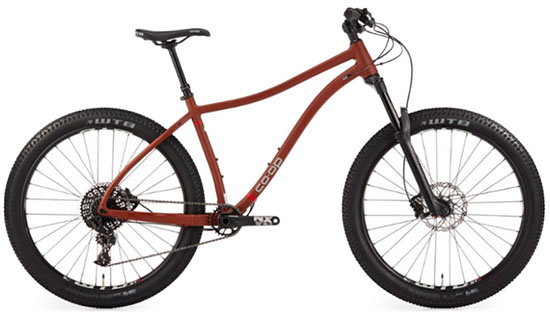 Category: Trail/XC
Category: Trail/XC
Suspension: 120mm or 140mm (front)
Tires: 27.5 x 2.8 in.
Gears: 1 x 12
What we like: REI’s excellent warranty and upgraded components like the NX drivetrain.
What we don’t: Fun factor can’t match the top picks.
REI’s in-house brand of bikes isn’t always at the forefront of modern design, but they consistently offer a lot of bang for your buck. Their hardtail DRT line is wide-ranging, including everything from the budget-oriented $599 DRT 1.1 to the $1,899 DRT 2.2 here. What you get with their top-end version is a nice collection of reliable components: The NX drivetrain is a worthwhile step up from the SRAM’s SX build, the brakes are mid-range hydraulic units from Shimano, and thru-axles are included for increased stiffness. With 120 millimeters on tap (140mm with size medium frames and up) and wide, 27.5+ tires, the DRT is well-suited for mixed cross-country and light trail riding.
As mentioned above, Co-op Cycles typically takes a conservative approach to design, and the DRT 2.2 is no different. It’s not particularly slack and won’t be the most fun on a techy descent, but the bike is comfortable and pedals pretty darn well. The DRT’s average all-around performance pushes it down our list a little (and below the more capable Timberjack), but we still think this bike will make a lot of folks happy. And with nationwide access to REI stores and bike shops, it also comes with an extra degree of security and convenience in case of any issues.
See the Co-op Cycles DRT 2.2
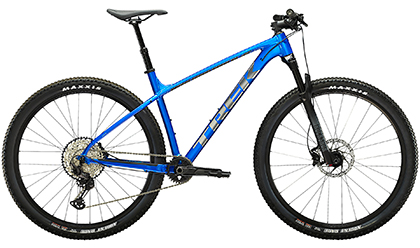
Category: XC
Suspension: 100mm (front)
Tires: 29 x 2.35 in. (27.5 in. on size S)
Gears: 1 x 12
What we like: Fast and efficient for long pedals.
What we don’t: It’s most comfortable on pretty tame terrain.
The bikes above trend towards the more capable, trail riding end of the spectrum, but if you’re more inclined for long cross-country epics, we recommend Trek’s X-Caliber. This bike has a strong racing lineage and is quick, responsive, and nimble on the trail. In addition, the X-Caliber is one of the lightest on this list, which helps with pedaling efficiency and all-around speed on flat or uphill terrain. Reasonably priced at $1,930, it’s a great starter XC race bike or a nice option for longer, less demanding trail days.
When the going gets rough, however, the X-Caliber comes up short. Its more limited suspension travel (100mm front) and upright riding position give it a sketchy personality on steeper trails filled with rocks and roots. As a result, we consider the X-Caliber less versatile than the picks above and harder to justify in a one-bike quiver (depending on where you live, of course). But if you’re craving a lightweight build for covering serious miles and are willing to give up a little in downhill capabilities, the X-Caliber is a proven choice.
See the Trek X-Caliber 9
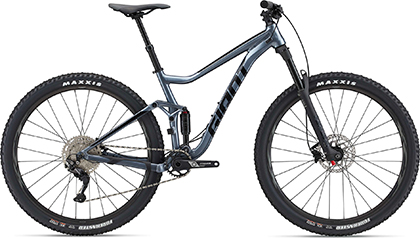 Category: Trail
Category: Trail
Suspension: 130mm (front) 120mm (rear)
Tires: 29 x 2.35 in.
Gears: 1 x 10
What we like: Great price for a full-suspension bike.
What we don’t: Harder to trust on rough trails.
We rarely recommend a full-suspension bike at such a low price-point—they’re typically too compromised in design and components—but the Marin above and Giant Stance here earn a spot on this list as decently capable rigs. Outfitted with an in-house 130-millimeter fork, entry-level Suntour shock, and 29-inch Maxxis tires, the Stance 2 is smooth and quick on the trail. And while its geometry could be seen by some as a bit dated and won’t feel super confident on steep descents, the cushioned ride is a nice consolation on more mellow terrain.
As expected, the Stance’s components are a step down from the hardtail models here, but there are some nice touches like the 10-speed Shimano Deore drivetrain and an included dropper post. Further, the bike is less rigid and trustworthy in rough terrain, especially when compared with the solid-feeling Marin above. That said, the sleek-looking Stance is a strong climber and will do the trick on flowy, less technical trail networks. And its well-built frame is a nice canvas for future upgrades.
See the Giant Stance 29 2
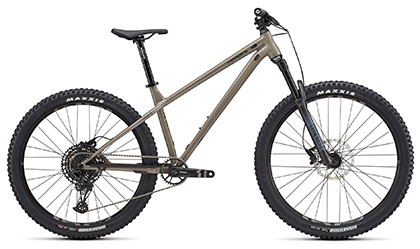 Category: Trail
Category: Trail
Suspension: 150mm (front)
Tires: 27.5/29 x 2.6 in. (29 in. on size L/XL)
Gears: 1 x 12
What we like: An aggressive bike with longer travel than other hardtails on this list.
What we don’t: No dropper post; less support and availability from a consumer-direct brand.
French direct-to-consumer brand Commencal built their Meta HT AM Ride on the idea that it’s better to have a high-quality hardtail than a poorly performing full-suspension bike. They combined aggressive geometry (including a 64-degree head tube) with a 150 millimeter-travel RockShox fork that’s the longest travel suspension fork on this list. Adding in burly tubeless-ready tires, thru–axles for added strength and stability, and SRAM’s 1 x 12 drivetrain makes the Meta a capable hardtail that’s ready both to climb and descend. Also of note, the small and medium frame sizes come set up with a 29-inch wheel in the front, 27.5 in the back for a better fit and more nimble ride (large and extra-large frames come as full 29ers).
The Commencal has much to offer riders looking for a quiver of one, and cutting out the middleman by ordering from a direct-to-consumer brand keeps the cost down. But ordering a bike online can also have its drawbacks. There’s nothing like taking a bike for a test ride before plunking down your hard-earned cash, which you likely won’t be able to do ordering from a direct-to-consumer brand. Commencal offers a five-year warranty, but customer service is all via phone or email, versus popping into your local shop for service. If the value of the Meta HT AM Ride is tempting but you’d prefer to shop locally, the Salsa Timberjack above offers a similarly aggressive setup—albeit with 20 millimeters less travel—but also includes a dropper post and mounts for racks for about $100 less.
See the Commencal Meta HT AM Ride
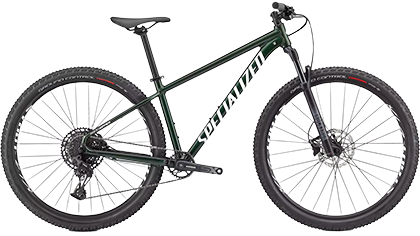 Category: XC/Trail
Category: XC/Trail
Suspension: 100mm (front)
Tires: 29 x 2.35 in.
Gears: 1 x 12
What we like: A versatile, high-quality bike that’s efficient on less technical terrain.
What we don’t: Less well suited to steeper or more technical trails.
Both the Specialized brand and their Rockhopper line have been big names in the mountain bike world for decades, and their latest iterations hold true to the reputation. This year’s Expert 29 combines efficient cross country-style geometry with mid-range components for a reasonable price. For $1,400, you get Specialized’s premium-level build quality plus a climb-ready 1 x 12 drivetrain, a RockShox Judy air fork (100mm of travel), SRAM Level hydraulic disc brakes, and tubeless-ready wheels to keep weight down on the trail. You also get Specialized’s lifetime frame warranty. It all adds up to a high-quality bike great for gobbling up moderate trails quickly.
However, there’s a reason most of the bikes on this list fall under the trail category instead of the cross-country category. Like the X-Caliber above, the Rockhopper won’t keep up when the trail gets rougher. The Rockhopper’s 29-inch wheels and economical geometry may eat up the miles on more smooth and rolling trails, but when pointed downhill or over rocky terrain, the riding position and bigger travel on a hardtail like Salsa’s Timberjack or the Commencal Meta HT AM Ride (for $399 and $500 more, respectively) will be more confidence inspiring. The choice may come down to what your local trails are like—and for faster, less technical rides, the Specialized Rockhopper is a tried-and-true choice.
See the Specialized Rockhopper Expert 29
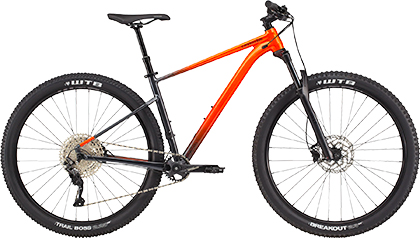 Category: Trail/XC
Category: Trail/XC
Suspension: 120mm (front)
Tires: 29 x 2.3 in. (front) 2.25 in. (rear)
Gears: 1 x 11
What we like: Great price + quality components = solid value.
What we don’t: Aggressive riders will find the Trail SE lacking.
Cannondale’s Trail line has been a long-time favorite for those getting into the sport, and their latest SE collection offers a nice upgrade in downhill performance. On singletrack, the Trail SE is thoroughly modern and pretty quick—a slackened head tube and decently steep seat tube put you in a balanced position for all-around riding. In addition, you get the same 1 x 11 Shimano Deore drivetrain as our top pick, and a TranzX dropper is included (the cheapest on our list to have this component). And as with many Cannondale bikes, the Trail SE features a high-quality aluminum frame with a lifetime warranty.
Unsurprisingly, the Trail SE’s affordable price tag comes with a few compromises. When held up against the competition, the Tektro hydraulic disc brakes don’t offer as much bite, and the WTB tires prioritize fast rolling over all-out grip. Upgrading to the Salsa Timberjack or Commencal Meta HT AM Ride above will address most of these issues, but you’ll face a hefty increase in price. For the budget shopper willing to put up with a couple small shortcomings, we think Cannondale’s Trail SE makes a great first “real” mountain bike.
See the Cannondale Trail SE 3
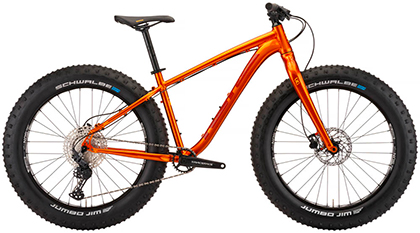 Category: Fat bike
Category: Fat bike
Suspension: None
Tires: 26 x 4.8 in.
Gears: 1 x 11
What we like: Fat bike fun with a good mix of components and price.
What we don't: Slow and heavy for regular singletrack use.
Kona may be better known for their lineup of mountain bikes, but the Wo is a serious contender in the world of fat bikes. We really like the Kona for its well-rounded spec package and competitive pricing. The proven and reliable 1 x 11 Shimano drivetrain provides plenty of gear choices for most undulating rides, and the 4.8-inch-wide Schwalbe-brand tires easily float on top of soft terrain. For a competitive $1,999, you get a trail-worthy fat bike that’s ready to tackle snow, sand, or mud.
Where does the Kona fall short? If you want a lightweight bike to ride year-round, then the Wo probably isn’t for you. We think the aluminum frame is more than sufficient for most recreational riders, but those looking for a racing machine should check out Salsa’s carbon fiber Beargrease models. And while the 4.8-inch-wide tires are great for covering ground during the middle of winter, once the singletrack trails turn to dirt, they will be undoubtedly slow and cumbersome given their weight. But these are inherent issues with fat bikes, and we think the Wo is currently one of the best mid-range options on the market.
See the Kona Wo
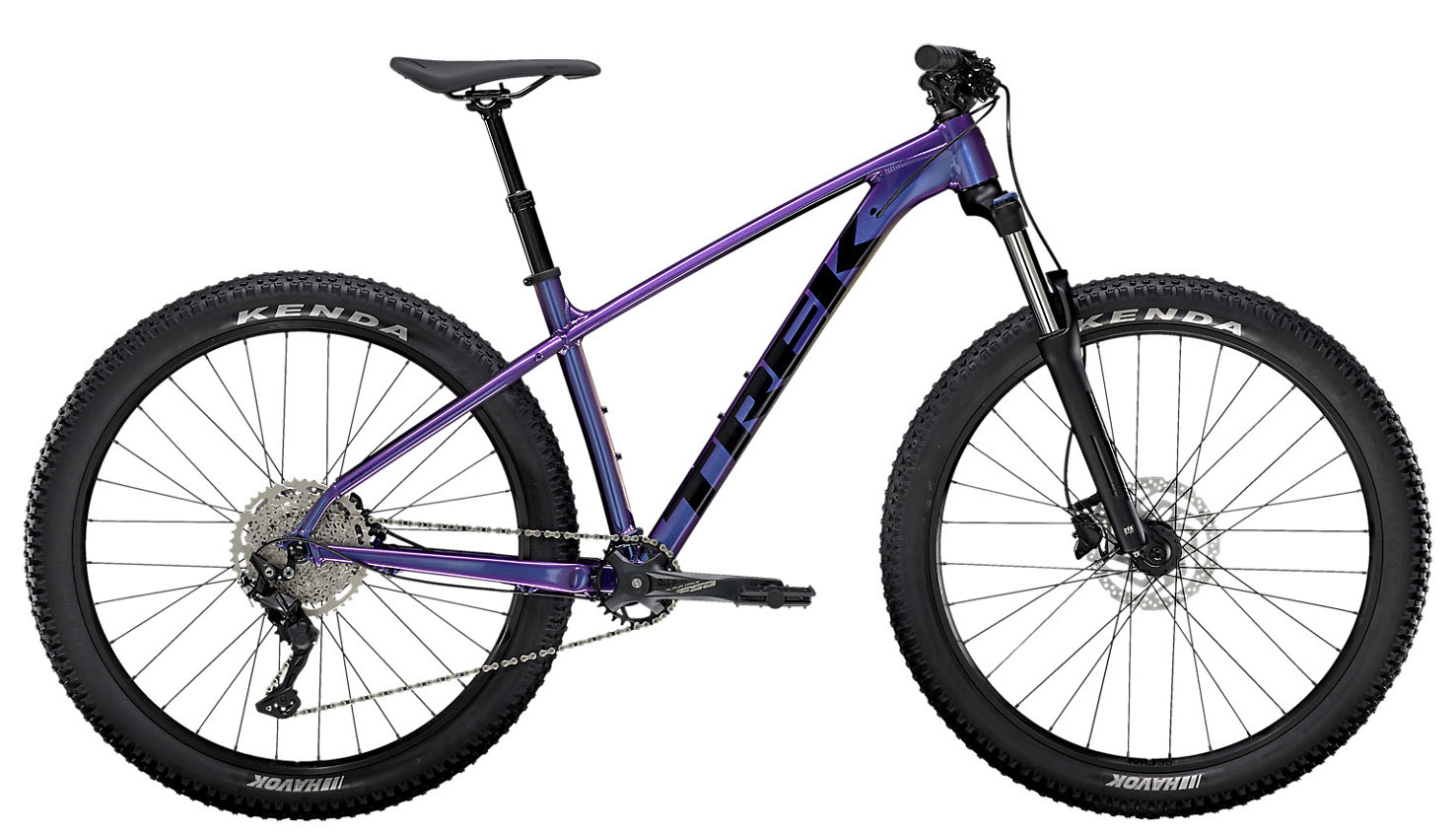 Category: XC/trail
Category: XC/trail
Suspension: 120mm (front)
Tires: 27.5 x 2.8 in.
Gears: 1 x 10
What we like: Great grip and cushioning from the 2.8-inch-wide tires; comes with a dropper post.
What we don’t: Budget price leads to downgraded parts.
Coming in at $1,180, the Trek Roscoe is the most affordable bike here and a solid starter option. While the Shimano Deore 10-speed drivetrain can’t match the gear range of the 11- and 12-speed designs above, it’s perfectly reasonable for all but the steepest of trails. And when it’s time to come back down, Shimano's hydraulic stoppers provide predictable and solid braking power. The SR Suntour 120-millimeter, coil-sprung fork will have expert riders wishing for more adjustments (pricier designs use air), but it is more than adequate for the majority of first-time mountain bike buyers.
As with any budget model, there are bound to be shortcomings, and the Roscoe 6 is no exception. In comparison, Cannondale’s Trail SE above boasts an upgraded drivetrain with a wider gear range. Additionally, the Trail SE’s RockShox Judy air fork offers much greater customization than the Roscoe’s SR Suntour. You’ll pay an extra $320 for the Cannondale, and its narrower tires make it a bit harsher in bumpy terrain, but the upgrades make it more capable overall. With that said, if you’re on a strict budget, we would happily recommend Trek’s Roscoe 6.
See the Trek Roscoe 6
| Bike | Price | Category | Suspension | Tires | Gears |
|---|---|---|---|---|---|
| Marin Rift Zone 27.5 1 | $1,899 | Trail | 130mm (front) 120mm (rear) | 27.5 x 2.3 in. | 1 x 11 |
| Salsa Timberjack SLX 29 | $1,799 | Trail | 130mm (front) | 29 x 2.6 in. | 1 x 12 |
| Co-op Cycles DRT 2.2 | $1,899 | Trail/XC | 120mm or 140mm (front) | 27.5 x 2.8 in. | 1 x 12 |
| Trek X-Caliber 9 | $1,930 | XC | 100mm (front) | 29 x 2.35 in. | 1 x 12 |
| Giant Stance 29 2 | $1,800 | Trail | 130mm (front) 120mm (rear) | 29 x 2.35 in. | 1 x 10 |
| Commencal Meta HT AM Ride | $1,900 | Trail | 150mm (front) | 27.5/29 x 2.6 in. | 1 x 12 |
| Specialized Rockhopper Expert 29 | $1,400 | XC/Trail | 100mm (front) | 29 x 2.35 in. | 1 x 12 |
| Cannondale Trail SE 3 | $1,500 | Trail/XC | 120mm (front) | 29 x 2.3/2.25 in. | 1 x 11 |
| Kona Wo | $1,999 | Fat bike | None | 26 x 4.8 in. | 1 x 11 |
| Trek Roscoe 6 | $1,180 | XC/Trail | 120mm (front) | 27.5 x 2.8 in. | 1 x 10 |
Cross-Country (XC)
As the name indicates, cross-country (XC) mountain bikes are typically made to be ridden on mellow terrain where the chances of encountering technical descents and jumps are unlikely. These rigs are designed to be as light and efficient as possible for long days and uphill travel and excel most on buff singletrack and fireroads. XC bikes will often lack rear suspension, have skinny and fast-rolling tires, feature short-travel forks (ranging from 80-100mm of travel), and have steep head tube angles, all in the name of efficiency and saving weight. A bike like the Trek X-Caliber 9 is great for XC racing and long days of riding but can’t match a trail or downhill bike on steep, techy trails.
.jpg)
Trail
The trail category is the most versatile and aims to split the lightweight XC models above and sturdy downhill styles below. For riders who want good climbing efficiency but a solid and capable feel on the descent, a trail bike is often the best choice. In terms of suspension, you’ll find a mix of hardtail and full-suspension designs and a bump up in travel compared with XC bikes (the average range is 120mm to 160mm). In our opinion, trail bikes are ideally suited for the majority of mountain bikers, and as a result, many of our top picks fall into this category. Some favorites include the Marin Rift Zone 27.5, Salsa Timberjack, and Commencal Meta HT AM Ride. And for those looking to stretch beyond the $2,000 limit here, we’ve also dedicated an article to the best trail mountain bikes.
Downhill/Park
Downhill and park bikes have one thing in mind: descending. They are typically the heaviest bikes in the group and prioritize traction and control over pedaling efficiency. Downhill bikes feature heavy and grippy tires, 180-200+ millimeters of travel, and are the slackest of the bunch. While downhill rigs are an absolute riot to ride, their lack of gearing and heavy weight render them useless when the trail points any direction but down. If you’re lucky enough to live somewhere like Whistler (where lifts can take you to the top), then a downhill bike makes sense. But for the rest of us sad souls, we’d be better served by the increasingly more capable trail bikes described above.
Fat Bikes
If the idea of riding on sand or snow sounds like the best way to explore on two wheels, then fat bikes should be at the top of your list. These bikes, highlighted by their bulbous and almost cartoonish-looking tires, are able to float on top of terrain that would otherwise halt a standard mountain bike in its tracks. Fat bikes typically have tires ranging from 3.5 to 5 inches in width, which, when combined with their ability to run very low pressures (5-15 psi), allow riders to stay atop soft terrain like snow and sand. Fat bikes can also be ridden on dirt trails, but because of their large and heavy tires, they will feel slow and quite sluggish when compared to standard mountain bikes. While fat bikes typically aren’t the most versatile rigs out there, they are undoubtedly fun on the right type of terrain.
In the $1,000 to $2,000 range, you’ll find yourself weighing a number of options, the most significant of which may be rear suspension. Is the extra cushion worth the added weight and complexity? At this price point, would a hardtail be a higher-quality, more reliable choice? One major factor to consider is where you typically ride: When the trails aren’t particularly rough, rear suspension isn’t necessary and a lightweight hardtail can actually be more fun and flickable. But on rugged terrain—like the rock- and root-filled Pacific Northwest—a full-suspension bike can be the difference between a fun ride and never wanting to touch your bike again.
.jpg)
Features and Components
Designing and building a rear suspension is a very complex, lengthy, and expensive process—not to mention the cost of the shock itself. As a result, you’ll see notable component upgrades on hardtails—particularly shifters, brakes, and the front suspension fork. For example, our top full-suspension pick, the Marin Rift Zone 27.5 1 ($1,899), comes with the same 1 x 11 drivetrain that you get on the $399-cheaper Cannondale Trail SE 3. Choosing a hardtail in the same price range as the Marin, like Salsa's Timberjack SLX, gets you upgraded shifters, a dropper post, and nicer brakes. These higher-end components are typically smoother-operating and longer-lasting. In sum, if you can do without a rear shock, you’ll be getting more bike for your money.
Wet-Weather Maintenance
Another factor to consider is long-term maintenance. Many folks will pick up a hardtail as a wet-weather or winter rig, as the rear linkage of a full-suspension bike is just one more thing to take care of. The additional pivots, bearings, and bushings require cleaning, re-greasing, and general love to keep from seizing up or rusting out, and when you come off the trail with bike and body completely covered in mud, it’s sometimes nice to simplify the cleanup. Here, bikes like the Commencal Meta HT AM Ride and Salsa Timberjack really come in handy: These capable hardtails are able to keep a similar pace with full-suspension models on many smoother trails, are a riot to ride, and are a breeze to maintain. All that being said, for folks that want a single bike to get them through the toughest terrain, it's hard to beat a quality full-suspension design.
29er
You’ll hear the term “rollover” used a lot in describing a 29er, and it’s a fair point. The larger wheels have a more favorable angle of attack and aren’t as affected by rocks and roots as a smaller wheel, which in turn lends to a more solid platform. This comes at the sacrifice of some quickness and playfulness on tight and twisty trails. Furthermore, wheelsets are heavier in this entry/mid-level category, and a 29er’s greater "wheel" estate translates to extra heft to drag up a long climb. A $2,000 29er is less of a grin-maker than a comparable 27.5 bike (or the old 26-inch), but it is a stable companion that allows a hardtail like the Salsa Timberjack or a full-suspension XC design to outperform expectations when the going gets rough.
.jpg)
27.5 (or 650b)
Riders looking for a playful bike that is easy to maneuver and responds eagerly to quick inputs will likely prefer the 27.5-inch wheel design. Also known as 650b, this wheel size is less cumbersome on tight trails than a comparable 29er, and smaller riders will find it often provides a better overall fit and feel. You will give up a bit in terms of pedaling efficiency and grip, and nothing can match the confidence-inspiring rollover of a 29er. But for uphill or fun-focused riders, a bike like the Marin Rift Zone 27.5 is lighter on climbs, easy to flick around, and delivers better acceleration too (for more, see our article on 27.5 vs. 29er mountain bikes).
27.5 Plus (Mid-Fat)
First there was the 29er, then came the 27.5, and now we have the 27.5 Plus. The first two refer simply to wheel diameter, while the final one tacks on an indicator of tire width. These tires are referred to as mid-fat or “plus,” and fall in between the standard 2- to 2.5-inch mountain bike tires and the true 5-inchers that you find on a fat bike. The benefits of a wider tire include increased stability, greater trail comfort, and traction. Obviously with more rubber comes more weight, and mid-range bikes that are already a little heavy can feel even more ponderous with plus tires. But done right, as is the case with the hardtail Co-op Cycles DRT 2.2, the 2.8-inch-wide tires do wonders for grip with few negatives.
.jpg)
At first glance, it may appear that having more gears is a good thing—20 is better than 12, right? But that 20-gear (2x10 crankset) ride can actually be more cumbersome to use. On the trail, you need crisp changes to react to rapid ascents and descents, and swapping from the big to small chain ring in the front is a real time-killer—not to mention it means excess weight and complexity. As manufacturers have found, a 1 x 11 or 1 x 12 drivetrain is the current sweet spot at this price with a wide enough but manageable range to handle the ups and downs of mountain biking. There are a few bikes under $2,000 still made with a front derailleur, but it’s notable that none made our list for 2022. Instead, the majority feature SRAM's or Shimano's entry-level but still good quality SX and Deore drivetrains, while some upgraded models include SRAM’s NX or Shimano’s SLX 12 speeds.
.jpg)
Weight is an unfortunate area of sacrifice at the under $2,000 price point. All of the fancy technology and materials that drive mountain bike weights lower and lower have a significantly higher cost of entry. For most casual riders, it’s less of an issue, but if your trails involve extended climbs up fire roads or singletrack, the excess weight can be a factor. If shaving weight is one of your top priorities and you’re trying to stick to a budget, a hardtail is your best choice. In terms of components, these bikes consistently do better at managing their heft, simply because there’s more leftover cash in the design budget when you don’t have to include a pricey rear shock and linkage.
Another way to trim weight from your bike is transitioning to a tubeless setup. Removing the tubes cuts away that all-important rotational weight and can be done quite inexpensively. Further, you can run at a lower PSI, which increases traction and comfort without the fear of flatting. Many of the bikes on this list have tubeless-ready tires, but you’ll need to verify that the rims are compatible. It’s also possible to set up a standard rim tubeless, but the process can be a little arduous the first few times.
Carbon fiber bikes are not new to the world of cycling, but they are certainly popular and often the center of attention on group rides. So what’s all the hoopla about? Carbon bikes are almost always lighter than their aluminum-frame counterparts, sometimes shaving up to 2 pounds. While most beginner riders probably won’t notice much of a difference, those racing the clock will certainly enjoy the decrease in weight. And carbon fiber is actually known to be stiffer than aluminum, which is a boon for efficiently transferring power. Finally, their lack of welds and smooth shapes give these bikes a premium, sleek look.
This boutique material is not without its downsides, however, and often costs hundreds, if not thousands, more than an equivalently spec’d aluminum counterpart. Prepare to get a lot less bike for your money should you go this route. Carbon frames are also said to be more susceptible to impending rock strikes and hits, something that aluminum can shrug off in most cases. And one of the biggest downsides of carbon fiber is that it is not easy to recycle, which is a positive upside for old aluminum bikes. Some brands, like Pole Bicycle Company, have actually decided to only produce aluminum bikes, stating that it is a more eco-friendly material (this argument is debatable, however). All in all, if you prioritize quality components over a light frame and want to keep your price point under $2000, then we think aluminum is the way to go. It’s no coincidence that all of the bikes to make our list have an alloy frame.
.jpg)
There’s a good chance that you do a lot of your shopping online, so why not do the same when you’re ready to pull the trigger on a new bike? With more and more companies offering online checkout options, and the emergence of consumer-direct brands like YT and Canyon (more on this below), there’s never been a better time. But before you skip the in-store experience, there are a few questions you should ask yourself. Are you comfortable with minor bicycle assembly and adjustments? Do you know which size you need or geometry that feels most comfortable? Will someone be home to receive the delivery of your expensive new ride?
A properly fitting bike is imperative for two-wheel enjoyment, and the thought of buying a rig without being able to throw a leg over it first may seem daunting for some. Luckily, almost all brands and online retailers provide an easy-to-follow size guide for their bikes. Simply locate your height on the chart and see which size it corresponds to. If you’d like to take it one step further, dive into the geometry chart, which shows frame dimensions for each size and can help you fine-tune your search. And if that isn’t enough for you, Competitive Cyclist has a comprehensive fit calculator which should more than satisfy the most discerning riders. While nothing beats seeing a bike in person, there are many sizing tools available online to meet most riders’ needs.
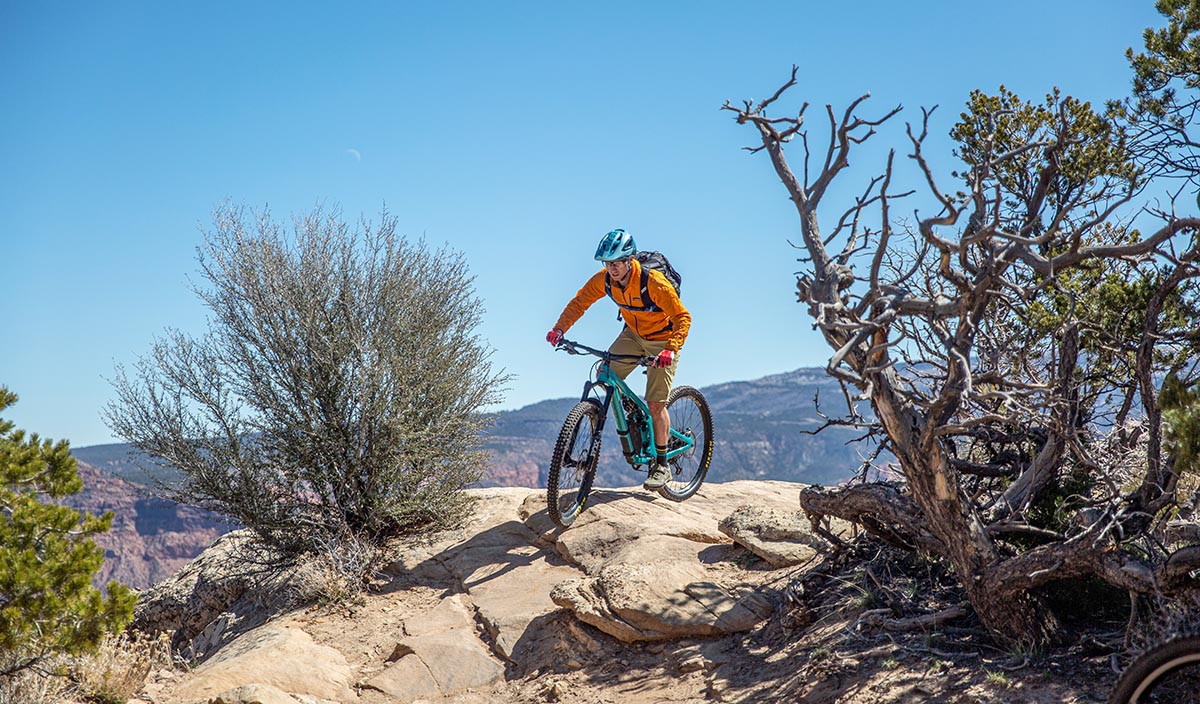
The majority of shipped bikes require some sort of assembly, so it’s important to have a working knowledge of how they are put together. In the most basic situation, you’ll need to install the front wheel and pedals of a shipped bike. This sounds easy in theory—and it often is—but wheels can sometimes be tricky to line up correctly and pedals have reverse threads, which can be confusing for first-timers. At the other end of the spectrum, you may be required to cut the fork’s steerer tube, install the bottom bracket, and route cables through the frame—all of which require special tools and mechanical know-how. Online programs like Diamondback’s Ready Ride provide great bike-building tutorials, and if all else fails, your local bike shop will happily assemble your bike and fix any, or all, of your mistakes. This in-person service does not come cheap, ranging from $75-$150, but knowing your bike was properly and professionally assembled will ease your mind when bombing down sketchy singletrack.
Consumer-direct brands like Canyon, YT, and Commencal have been gaining a lot of momentum in the U.S. market over the past few years. The reason: compared with traditional brands that work through brick-and-mortar bike shops, these online-only companies offer better bang for your buck. As an example, Commencal’s Meta TR Ride ($3,300) and Santa Cruz’s Hightower R ($4,299) go toe-to-toe with their aluminum frames, 29-inch wheels, and mid-tier drivetrain and suspension components. But with a $999 difference in price and fairly similar on-trail performance (the Hightower is slightly more refined), the Commencal makes a very strong case for itself. And similar comparisons can be drawn with YT’s full-suspension bikes and Canyon’s array of gravel, road, and MTB offerings.
There’s no denying the fact that consumer-direct companies sell their bikes at enticing prices, but is it too good to be true? You’ve likely heard some horror stories about poor customer support, long wait times, and lack of inventory altogether. Plus, there’s a good chance you won’t be able to give the bike a test ride prior to purchasing. And finally, there’s something to be said for supporting your local bike shop. However, if you’re simply looking for the best value bike on the market—and aren’t too risk-averse to the potential downsides—it’s hard to ignore consumer-direct companies.
Buying a used bike is a great way to cut down on waste and extend the life of a product, but there are a number of things you should consider before going down that path. The main appeal to buying used is saving money, but unmaintained bikes may end up costing you a lot in future repairs (and you won’t be able to utilize the manufacturer warranty in most cases). It’s important to check the drivetrain for wear: specifically, are the chainring teeth shaped like shark fins (as opposed to triangles), or missing altogether? If so, then those need to be replaced. How many miles does the chain have on it? Use a chain checker tool to see if it’s worn out. It’s also important to closely inspect the bike frame for cracks or major dents—if either are present, we recommend moving on.
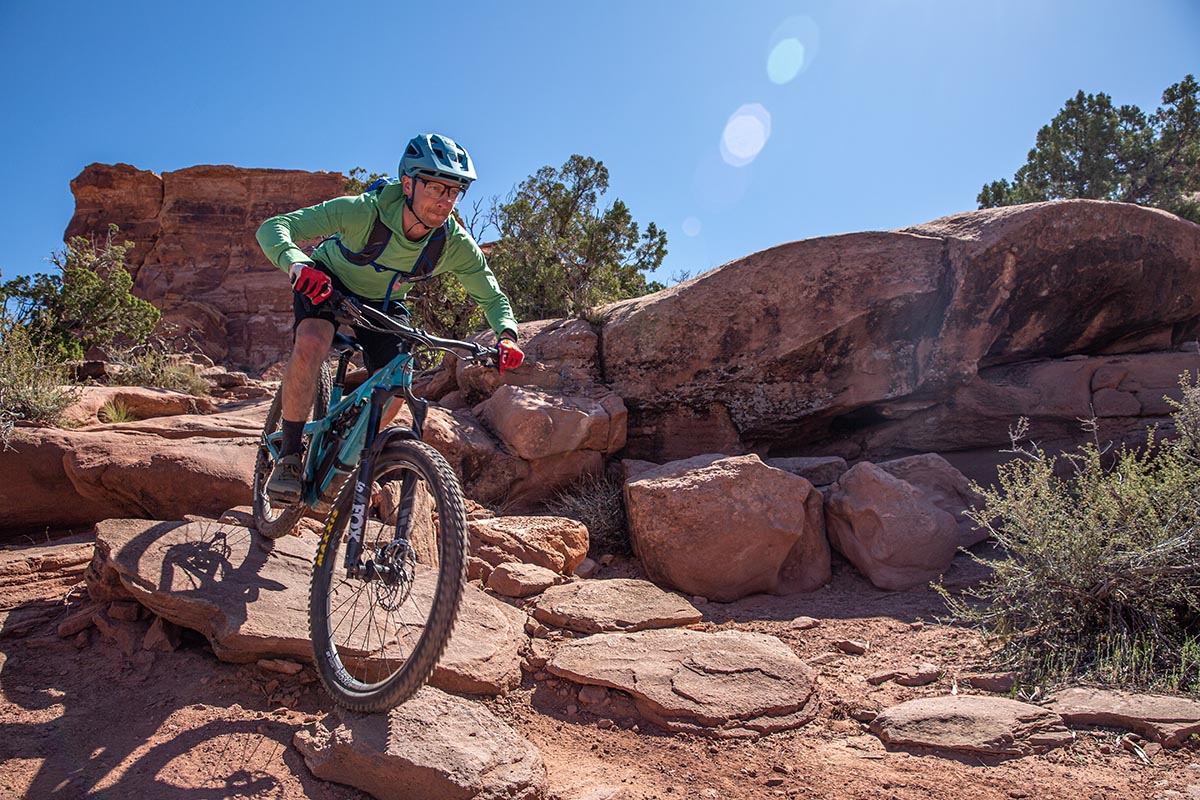
Similar to buying a pre-owned car, the best way to ensure you're purchasing a quality used bike is to have a shop check it out. We recommend calling ahead of time and asking if a bike technician can take a few minutes to go over the bike. When you’re spending hundreds (or thousands) of dollars, we think it’s worth the time and hassle for a professional opinion. All in all, buying used can be a great way to get a quality bike at half the original price, but just be aware of the possible risks that are involved.
Back to Our Top Mountain Bike Picks Back to Our Mountain Bike Comparison Table